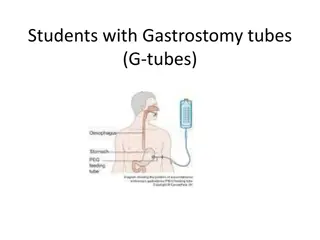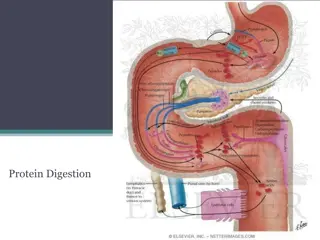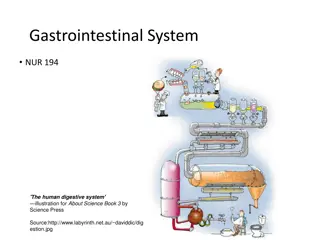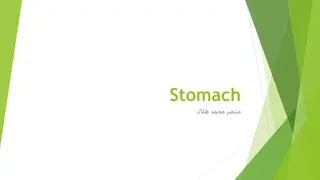Digestive System
Learn about the digestive system's organs and functions in turning food into nutrients for energy and growth. Explore the mouth, throat, esophagus, stomach, and small intestine processes. Discover mechanical and chemical digestion examples.
7 views • 13 slides
Understanding Gastrostomy Tubes (G-tubes) in Students
Gastrostomy tubes (G-tubes) are essential medical devices for students that provide a safe and efficient way for delivering food, medications, and fluids directly into the stomach. These tubes are inserted through a surgical opening into the stomach and are crucial for maintaining proper nutrition a
1 views • 14 slides
Understanding the Digestive System Processes
The digestive system is responsible for the breakdown, absorption, and elimination of food. It involves processes such as ingestion, propulsion, mechanical and chemical digestion, absorption, and defecation. Starting from the mouth with salivary glands and oral cavity, it progresses through the esop
3 views • 38 slides
Physiologie Digestive PHASE BUCCALE
Digestive physiology involves the breakdown of food into simple nutrients for absorption by the body. It includes mechanical and chemical means of food degradation using enzymes from salivary, gastric, pancreatic, and colonic bacteria. The digestive system comprises the mouth, esophagus, stomach, li
4 views • 25 slides
Best Prostate Cancer Treatment Hospitals in India
The prostate is a soft organ in reproductive anatomy. It is nearly about the size of a chestnut. Its weight is around 30 grams. It is located in the pelvis below the bladder with the urethra passing through. It is surrounded by an elastic, fibromuscular capsule and contains glandular tissue and conn
1 views • 2 slides
Global Weight Loss Stomach Pump Market
The Global Weight Loss Stomach Pump Market Size is Anticipated to Exceed USD 541.05 Million by 2033, Growing at a CAGR of 4.35% from 2023 to 2033.\n\n
0 views • 5 slides
Understanding constipation, scant feces, and alimentary tract hemorrhage in farm animals
Constipation in farm animals is characterized by decreased frequency of defecation and dry, hard feces. Scant feces are small quantities of feces, commonly seen in animals with stomach abnormalities. Alimentary tract hemorrhage can result from various causes, including ulcers and infestations. Hemor
0 views • 12 slides
Protein Digestion and Metabolism in Ruminants and Non-Ruminants
Digestion and metabolism of protein in both ruminants and non-ruminants involve enzymatic breakdown of proteins into polypeptides and amino acids in the stomach and intestines. Key enzymes such as pepsin, trypsin, and chymotrypsin play important roles in protein digestion. Gastric digestion in the s
3 views • 14 slides
Understanding Glandular Specialized Epithelium and Glands
Glandular specialized epithelium forms a class of epithelial tissues with specific functions and structures, composed of cuboidal, columnar, and ciliated columnar epithelial cells. These tissues contain gland cells that are secretary in nature, with zymogen granules in the cytoplasm. Glands are spec
1 views • 35 slides
Understanding Glandular Epithelium and Secretory Cells
Glandular epithelium consists of epithelial cells specialized in producing and secreting various macromolecules, found in glands throughout the body. These secretory cells can synthesize proteins, lipids, and carbohydrates, with different types of glands such as exocrine and endocrine glands. The se
0 views • 13 slides
Drugs Affecting the Digestive System and Their Functions
This presentation by Dr. Archana covers various drugs that impact the digestive system, such as antacids, intestinal astringents, antiemetics, and more. It explores the functions of these drugs and their roles in treating stomach-related issues like gastritis and peptic ulcers. The chapter discusses
0 views • 20 slides
Understanding Epithelial Tissue: Characteristics, Types, and Functions
Epithelial tissue is a crucial component of the body forming protective barriers, aiding in secretion, absorption, excretion, and more. Learn about its general characteristics, different types such as simple and stratified epithelium, glandular epithelium classification, and clinical applications li
0 views • 12 slides
Understanding Gastric Motility and Secretion in the Stomach
This content delves into the intricate workings of the stomach, focusing on its motor functions, anatomical and physiological divisions, gastric reservoir, storage and mixing functions, and relaxation reflexes. It emphasizes the key roles of the stomach in storing and preparing food for digestion, a
0 views • 47 slides
Understanding Protein Digestion and Amino Acid Metabolism
The process of protein digestion involves proteolytic enzymes produced by the stomach, pancreas, and small intestine. Pepsinogen is activated to pepsin in the stomach, breaking down proteins into oligopeptides and amino acids. After absorption, amino acids are utilized for protein synthesis and as d
0 views • 7 slides
Understanding Gastric Motility and Secretion in the Stomach
The stomach plays a crucial role in food processing, acting as a reservoir, preparing chyme for digestion, and facilitating absorption. Divided anatomically and physiologically, it functions as a storage unit and mixing chamber for food. Key motor functions include storage, preparation for digestion
0 views • 49 slides
Understanding Resins in Pharmacognosy: Properties and Occurrence
Resins are solid or semi-solid amorphous products rich in carbon atoms, found in plants, animals, and fossils. They contain essential oils, terpenes, and carboxylic acids. Resins have unique chemical and physical properties and are secreted in specialized structures like resin cells and glandular ha
0 views • 11 slides
Utilization of Glandular By-Products in Slaughter Technology
Animal glands, rich in healing substances, are valuable by-products in the pharmaceutical industry. This article emphasizes the overlooked potential for utilizing glands in India, focusing on collection and preservation methods to maintain the efficacy of hormones and enzymes extracted for medicinal
0 views • 22 slides
Structure and Function of a Serous Compound Tubulo-acinar Gland
A detailed description of a compound tubulo-acinar gland with serous-secreting nature is provided, highlighting its cellular composition, arrangement of ducts, and connective tissue organization. The glandular structure, including adenomeres, centroacinar cells, and myoepithelial cells, is discussed
0 views • 15 slides
Histology Overview of Digestive and Urinary Tracts in Pharmacy Practice
This histology practice session delves into the intricate details of the digestive and urinary tracts studied in the 8th week of Pharmacy school. Explore images showcasing the structures of the colon, vermiform appendix, liver, pancreas, and nephron. Gain insights into the histological features of t
0 views • 19 slides
Understanding the Secretions of the Gastrointestinal Tract (GIT)
The gastrointestinal tract (GIT) is responsible for digestion, absorption, and secretion through various glands along the alimentary canal. Secretions are stimulated by factors like direct contact, nervous system activation, and hormonal regulation. Hormones released in response to food presence hel
0 views • 7 slides
Understanding the Anatomy and Function of the Stomach
The stomach is a vital organ in the digestive system with functions like food storage, mixing with gastric secretions, and controlling chyme delivery to the small intestine. It has a J-shaped structure with various parts like the fundus, body, antrum, and pylorus. The lesser and greater curvatures,
0 views • 21 slides
Understanding Digestion: A Journey Through the Digestive System
Dive into the fascinating world of digestion with a focus on the organs involved, processes like chewing and absorption, and the role of nutrients. Explore the journey of a pretzel through the digestive system and learn about key concepts such as the functions of the mouth, pharynx, esophagus, stoma
0 views • 12 slides
Understanding the Human Digestive System
The human digestive system is a complex pathway that starts from the mouth and ends at the anus, involving various organs like the mouth, pharynx, esophagus, and stomach. Each part plays a crucial role in breaking down food particles, absorbing nutrients, and eliminating waste products. From chewing
0 views • 132 slides
Understanding Peptic Ulcers: Causes, Symptoms, and Treatment
Peptic ulcers are open sores that form in the stomach or upper small intestine, leading to symptoms like stomach pain, bloating, and nausea. Common causes include H. pylori infection and NSAID use. Recognizing symptoms, such as burning stomach pain, is crucial for timely diagnosis and management. Se
0 views • 19 slides
Understanding Epithelial Tissues: Structure and Function
Epithelial tissues play crucial roles in the human body, covering surfaces, lining cavities, and forming glands. They are highly cellular and rest on a basement membrane, separating them from connective tissues. Epithelial tissues serve functions such as protection, absorption, secretion, and contra
0 views • 15 slides
Anatomy and Blood Supply of the Equine Stomach
The equine stomach is relatively small compared to the horse's body size, with distinct regions such as the cardia, fundus, body, and pyloric region. It is located on the left side of the abdomen, under the ribs. The stomach's blood supply includes branches from the aorta, splenic artery, and hepati
0 views • 23 slides
Functions and Secretions of the Stomach
The stomach plays crucial roles in digestion through its secretions such as stomach juice, hydrochloric acid, and mucus. These secretions aid in breaking down food components, promoting optimal enzymatic activity, and providing a protective barrier against bacteria. The stomach juice is composed of
0 views • 8 slides
Radiology Imaging of Esophagus and Stomach by Dr. A. Alhawas
View detailed radiology imaging of the esophagus and stomach conducted by Dr. A. Alhawas, showcasing various anatomical structures such as the splenic artery, abdominal aorta, common hepatic artery, and more. Explore pathologically changed layers in pyloric stenosis, arterial blood supply to the pyl
0 views • 8 slides
Overview of Stomach Surgery and Treatment Options
The stomach plays a crucial role in digestion and is divided into four regions - cardia, fundus, body, and pyloric part. Understanding the anatomy of the stomach is essential for surgical interventions, including treatment for benign and malignant gastric diseases like peptic ulcer disease. Surgical
0 views • 30 slides
Comprehensive Guide to Stomach Anatomy, Histology, and Barium Meal Radiology
Learn about the intricate anatomy of the stomach, its histological structure, lymphatic drainage, and the use of barium meal radiology for diagnostic purposes. Discover indications and contraindications, patient preparation, and clinical scenarios where these procedures are essential.
0 views • 29 slides
Understanding the Anatomy of the Stomach
The stomach, also known as the gaster or venter, is a vital organ in the digestive system. It is a muscular bag that plays a crucial role in food digestion and absorption. This article covers the surface anatomy, external and internal features, blood supply, nerve supply, lymphatic drainage, clinica
0 views • 32 slides
Gastric Motility and Secretion in the Stomach: Functions and Division Overview
The stomach plays crucial roles in food storage, chyme preparation, water absorption, and slow emptying into the small intestine. Its motor functions include maintaining a reservoir, mixing food, and facilitating relaxation reflexes for optimal digestion. Anatomically and physiologically, the stomac
0 views • 46 slides
Overview of Esophagus and Stomach Imaging Techniques
This content provides information on various imaging modalities used in examining the esophagus, including CT scan, MRI, Fluoroscopy, US, X-ray, and Nuclear medicine. Detailed images and descriptions of esophageal anatomy, abnormalities, and stomach anatomy are included, along with explanations of p
1 views • 33 slides
Understanding Gastric Motility and Function in the Gastrointestinal Tract
The stomach plays a crucial role in digestion, from storage and mixing of food to slow emptying of chyme into the duodenum. Gastric motility involves peristalsis and retropulsion, essential for propelling food towards the pylorus. Dr. Muntadher Abdulkareem Abdullah provides valuable insights into th
0 views • 13 slides
Various Stomach Anatomy Slides of Different Animal Species
Explore a series of detailed histological slides showcasing the stomach anatomy of different animal species including cats, rabbits, dogs, pigs, sheep, and goats. The images highlight key features such as gastric pits, mucosal layers, chief and parietal cells, proper gastric glands, cardiac and pylo
0 views • 29 slides
Exploring the Human Digestive System: Major Organs and Functions
The human digestive system is a complex network of organs working together to break down food into smaller molecules for absorption. It consists of major organs like the mouth, esophagus, stomach, small intestine, and large intestine, along with accessory organs such as the liver, gallbladder, and p
0 views • 34 slides
Structure of Gastric Mucosa in Glandular Stomach
The glandular stomach features laminae epithelialis lined with simple columnar epithelium, leading to differentiation into gastric pits and glands. The laminae propria houses tubular gastric glands, while the laminae muscularis mucosa is composed of smooth muscles. Different regions exhibit distinct
0 views • 14 slides
Perianal Suppuration: Abscess & Fistula Overview
Anorectal suppuration can lead to acute anal sepsis (abscess) or chronic anal fistula. This condition involves glandular secretions, infection, and suppuration, often originating from cryptoglandular sources. It can be caused by various specific conditions like Crohn's disease, ulcerative colitis, T
0 views • 47 slides
Analytical Toxicology: Techniques and Sample Analysis in Clinical Toxicology
Analytical toxicology involves the observation, identification, and measurement of foreign compounds in biological and other samples, such as urine, blood, stomach contents, nails, hair, and DNA. Various techniques are used to isolate and identify drugs and poisons present in these samples. This fie
0 views • 12 slides
Understanding Basic Histology and Tissue Types
Explore histology, tissues, and types of tissues including epithelial, connective, muscle, and nerve tissues. Learn about tissue characteristics, differences, and functions, as well as details on specific tissue types like cardiac muscle, bone tissue, skeletal muscle, and smooth muscle. Delve into e
0 views • 74 slides







































